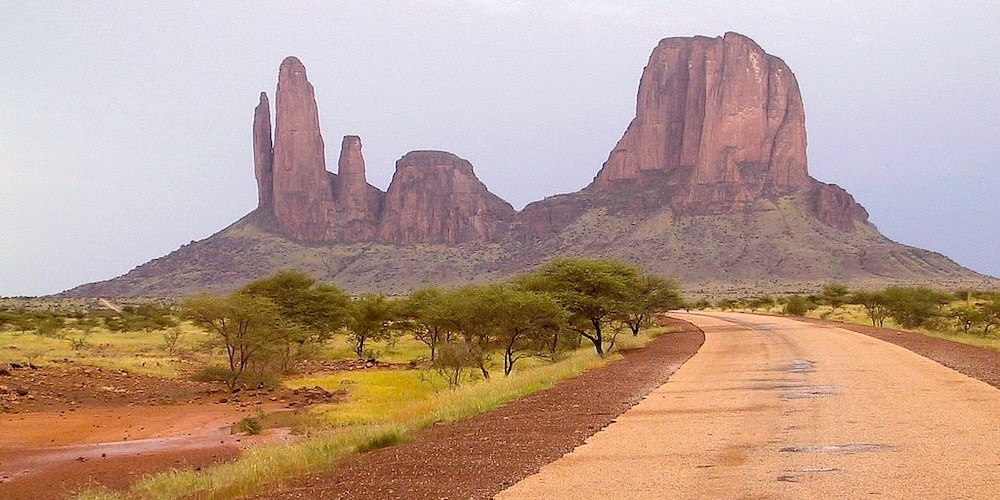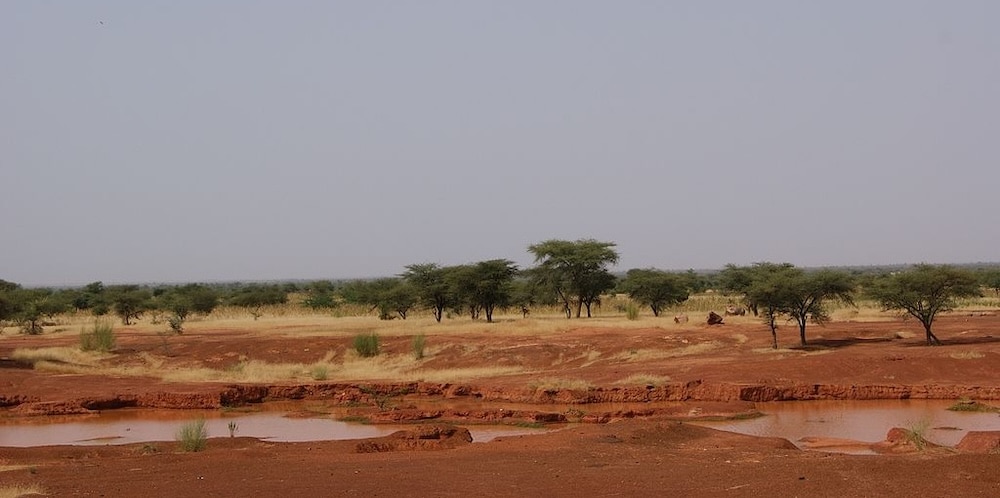Republic of Mali

Mali is a landlocked country in West Africa. It is the eighth-largest country in Africa, with an area of over 1,240,000 km2 (nearly 479,000 square miles). The country is bordered to the north by Algeria, to the east by Niger, to the northwest by Mauritania, to the south by Burkina Faso and Ivory Coast, and to the west by Guinea and Senegal. The population of Mali is about 25 million. Its capital and largest city with is Bamako, which metropolitan area has c. four million inhabitants. The country has 13 official languages, of which Bambara is the most commonly spoken. Its northern borders reach deep into the middle of the Sahara Desert. The country’s southern part, where the majority of inhabitants live, is in the Sudanian savanna and has the Niger and Senegal rivers running through it. The country’s economy centres on agriculture and mining with its most prominent natural resources including gold (of which it is the third largest producer in Africa), uranium, phosphates and salt. Cotton is the country’s largest crop export and is exported west throughout Senegal and Ivory Coast. 80% of workers are in agriculture.
Most of the country lies in the southern Sahara Desert, which produces an extremely hot, dust-laden Sudanian savanna zone. It is mostly flat, rising to rolling northern plains covered by sand. The Adrar des Ifoghas massif lies in the northeast.
Mali lies in the torrid zone and is among the hottest countries in the world. The thermal equator, which matches the hottest spots year-round on the planet based on the mean daily annual temperature, crosses the country. Most of Mali receives negligible rainfall and droughts are very frequent. Late April to early October is the rainy season in the southernmost area. During this time, flooding of the Niger River is common, creating the Inner Niger Delta.

The Hand of Fatima – ©Timm Guenther (Timm Busshaus) CC BY-SA 3.0 via Wikimedia Commons
The vast northern desert part of Mali has a hot desert climate with long, extremely hot summers and scarce rainfall which decreases northwards.
The central area has a hot semi-arid climate with very high temperatures year-round, a long, intense dry season and a brief, irregular rainy season. The southern areas have a tropical wet and dry climate. It faces numerous environmental challenges, including desertification, deforestation, soil erosion, and inadequate supplies of potable water.
Birding Mali
Five terrestrial eco-regions lie within Mali’s borders: Sahelian Acacia savanna, West Sudanian savanna, Inner Niger Delta flooded savanna, South Saharan steppe and woodlands, and West Saharan montane xeric woodlands.
The vegetation zones are the Saharan, the Sahel, and the Sudan-Guinea Savanna. There is very little wild life and a few national parks in Mali. The reserve and largest national park is the Boucle du Baoulé National Park covering 7,710 km2 located to the northeast of Bamako. There is hardly any wild life left in this park due to intense poaching of elephants, giraffes, buffalo, chimpanzees and lions. Monkeys are the only animals regularly seen now, is in the southeast, near the border with Niger. The Reserve de Douentza is the most interesting in terms of wildlife. Bafing National Park covering 5,000 km2 is in the south west bordering with Guinea which is a dry area between Mopti and Gao; it is home for desert elephants which move with change of seasons. The other notable parks are the Wongo National Park and the Kouroufing National Park. The Bafing Biosphere Reserve covers an area of 5,215 km2 and the Bafing Chimpanzee Sanctuary is exclusive to conserve chimpanzees.

Road to Timbuctu – ©Annabel Symington CC BY 2.0 via Wikimedia Commons
There are 146 species of mammals although none in huge numbers. However, there are seventeen Important Bird Areas (IBAs), encompassing an area of nearly 29,000 km2 (about 2.3% of the surface area of the country). Ten include wetlands, nine are in the Inner Delta of the Niger river (key bird area), four include the Sudan-Guinea ecoregion of the Savanna biome, four are in the Sahel biome, and two in the Sahara-Sindian biome. The Kulicoro Firefinch, also known as the Mali Firefinch Lagonostica virata, is the only endemic bird of Mali, found in rocky and grassy areas near Mopti and Bamako.
In these IBAs, 622 bird species have been recorded; there have been 335 resident species noted, with 202 of these breeding in Mali. Additionally, 137 species of the noted 243 migratory species are of Palaearctic origin.
The Inner Delta is also rich in waterfowl and heron species, particularly the cosmopolitan Western Cattle Egret Bubulcus ibis and Great Egret Casmerodius albus, as well as the world’s largest heron; Goliath Heron Ardea goliath.
-
Wikipedia
GNU Free Documentation License
https://en.wikipedia.org/wiki/Mali
-
Number of bird species: 619
(As at February 2025)
Number of endemics: 1
Mali Firefinch Lagonosticta virata
-
Avibase
PDF ChecklistThis checklist includes all bird species found in Mali , based on the best information available at this time. It is based on a wide variety of sources that I collated over many years. I am pleased to offer these checklists as a service to birdwatchers. If you find any error, please do not hesitate to report them. -
E-Bird
PDF ChecklistThis checklist is generated with data from eBird (ebird.org), a global database of bird sightings from birders like you. If you enjoy this checklist, please consider contributing your sightings to eBird. It is 100% free to take part, and your observations will help support birders, researchers, and conservationists worldwide. -
Wikipedia
Annotated ListThis is a list of the bird species recorded in Mali. The avifauna of Mali include a total of 617 species, of which one is endemic.
-
Birds of Western Africa
| By Nik Borrow & Ron Demey | Christopher Helm | 2014 | Edition 2 | Paperback | 592 pages, 266 plates with colour illustrations; colour distribution maps | ISBN: 9781472905680 Buy this book from NHBS.com -
Birds of Western and Central Africa
| By Ber van Perlo | Princeton University Press | 2003 | Paperback | 384 pages, 109 plates with colour illustrations; colour & b/w illustrations, 1500+ b/w distribution maps, colour maps | Out of Print | ISBN: 9780691007144 Buy this book from NHBS.com

Birds of Africa
Apple iOS | AndroidBirds of Africa is an identification guide which in time will cover all the birds and countries in Africa. This version includes more than 1,800 species and has all West African and 8 East African countries.Organisations-
African Bird Club
WebsiteMali contains within its borders huge extremes of habitats, vegetation and avifauna. Key wintering grounds for Palearctic waterbirds and breeding areas for African waterbirds are found where the Niger River forms a large interior delta between the historic cities of Djenne and Timbuktu. The Sahara desert occupies the entire northern half of Mali, and the Sahel zone runs through Mali from east to west, each with its own unique avifauna. -
Maliasili
WebsiteMaliasili strengthens organizations, enhances leadership capacity, and helps local organizations get more money. The result: increased impact across their communities and landscapes -
Oiseaux du Mali
Facebook PageGroup -
West African Ornithological Society
WebsiteThe West African Ornithological Society grew out of the Nigerian Ornithologists
Reserves-
*Protected areas of Mali
InformationSatellite ViewInteracxtive list of reswerves, p[arks etc. -
IBAs
WebsiteSatellite ViewThere are 17 Important Bird Areas (IBAs) and one secondary Endemic Bird Area (EBA) designated by BirdLife International in Mali -
NP Bafing
InformationSatellite ViewBafing National Park is the only protected area for chimpanzees within the Manding Plateau area. Woodlands dominate most of the landscape. -
NP Boucle du Baoulé
InformationSatellite ViewIt is part of a complex which also includes the Badinko Faunal Reserve, the Fina Faunal Reserve, the Kongossambougou Faunal Reserve and the Bossofola Forest Reserve. These preserved areas consist of desert and semi-desert areas, and include dry, lightly-wooded savannah, riverine forest and thorn scrub. Much of the large animal population in the country occurs in these types of habitat. -
NP Kouroufing
InformationSatellite View -
NP Wongo
InformationSatellite ViewThe Wongo National Park is found in Mali. It was established on the 16th of January 2002, and covers 534 km2 (206 sq mi).
Sightings, News & Forums-
eBird
SightingseBirding This Month
Guides & Tour Operators-
NatureTrek
Tour OperatorTour Code: MLI01A 17-day tour featuring visits to the fabled city of Timbuktu, a boat trip on the River Niger, and time with one of the purest animist-fetishist cultures in Africa. A diverse and exciting array of birds and other wildlife is also observed.
Trip Reports-
2008 [11 November] - Andy Smith
PDF Report...wooded botanic gardens and then watched the sunset from the riverside terrace of the hotel Mande, beer in hand. A surprisingly wide range of birds during this interesting and relaxing day provided a useful introduction to the Malian avifauna and included a few species that we didn’t see elsewhere in the country. Among the highlights were Western Grey Plantain-eater, Senegal Parrot, African Thrush, Yellow-crowned Gonolek, Yellow-billed Shrike, Grey-headed Bush Shrike, Bronze-tailed Glossy Starling and Beautiful Sunbird... -
2017 [12 December] - Robert Tovey
ReportDay two at Mali National Park, Bamako
Other Links-
Birdlife Data
InformationBackground bird facts for Mali
-
Fatbirder - linking birders worldwide...
Skip to content
